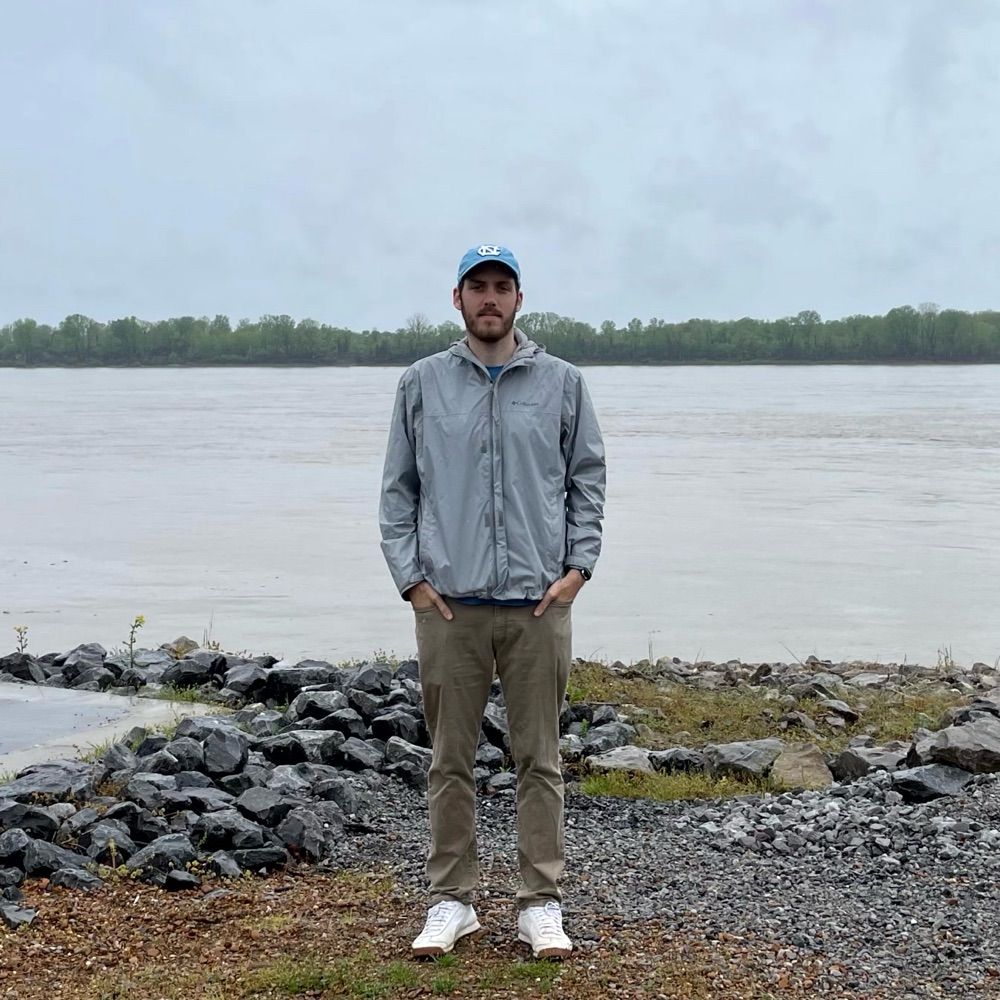'Disc Golf Anywhere' is an ongoing series. It explores ideas for fitting innovative disc golf facilities in nooks and crannies where more communities can enjoy the benefits of the game, such as increasing physical and mental health, turning neglected spaces into bustling hubs of activity, and affordability (89% of courses are free to play).
From Developing Software to Developing Disc Golf
Kevin Farley of Muskoka, Ontario, Canada, built his first disc golf course in 2012, but it wasn't until 2019 that he made it a full-time pursuit. With a background in software development for business process automation, Farley had made a career of helping businesses move their services online. After a snowboarding accident in Whistler, British Columbia, though, long hours of coding in a desk chair weren't ideal.
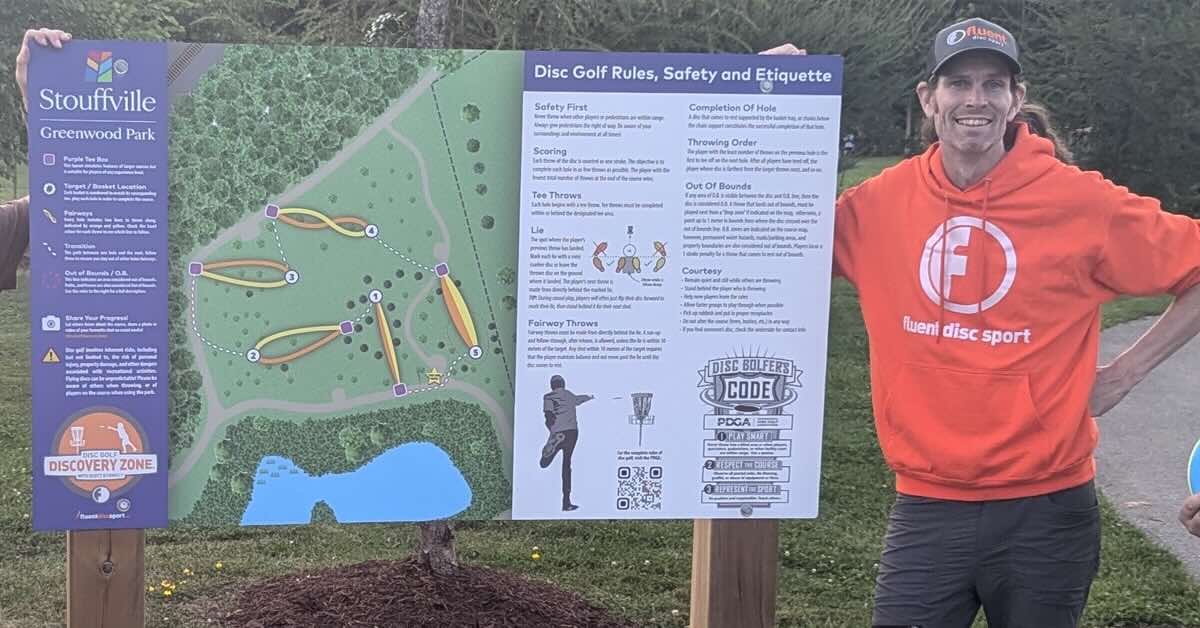
" I needed to be more active," said Farley. "I needed to get out of the chair. I just needed a change. And my wife said that as long as I could make money doing it, then she'd support whatever I chose to do. And disc golf was something that I really started to see some real potential in."
So Farley founded Fluent Disc Sport, a disc golf course design firm focused on safety, sustainability, accessibility, and excellent player experience.
Why Make Smaller Disc Golfer Courses?
After starting Fluent, one of Farley's first objectives was to identify the largest hurdles in the way of his new market's growth. His thinking and research led him to believe there were three key barriers to more people playing disc golf and more courses going in the ground.
One of them was that disc golf courses were often built in low-traffic and/or remote areas, making it unlikely for people to discover the game by chance.
"Almost every disc golfer was introduced to the sport by another player," Farley explained. "And that's a slow way to grow. It's very grassroots, but it really slows down the pace of growth."
Farley's point is backed up by a 2023 UDisc survey, where 78% of thousands of respondents said they started playing disc golf based on a family or friend's recommendation. Only 10% of players discovered the sport because they saw a disc golf course and decided to try the game out.
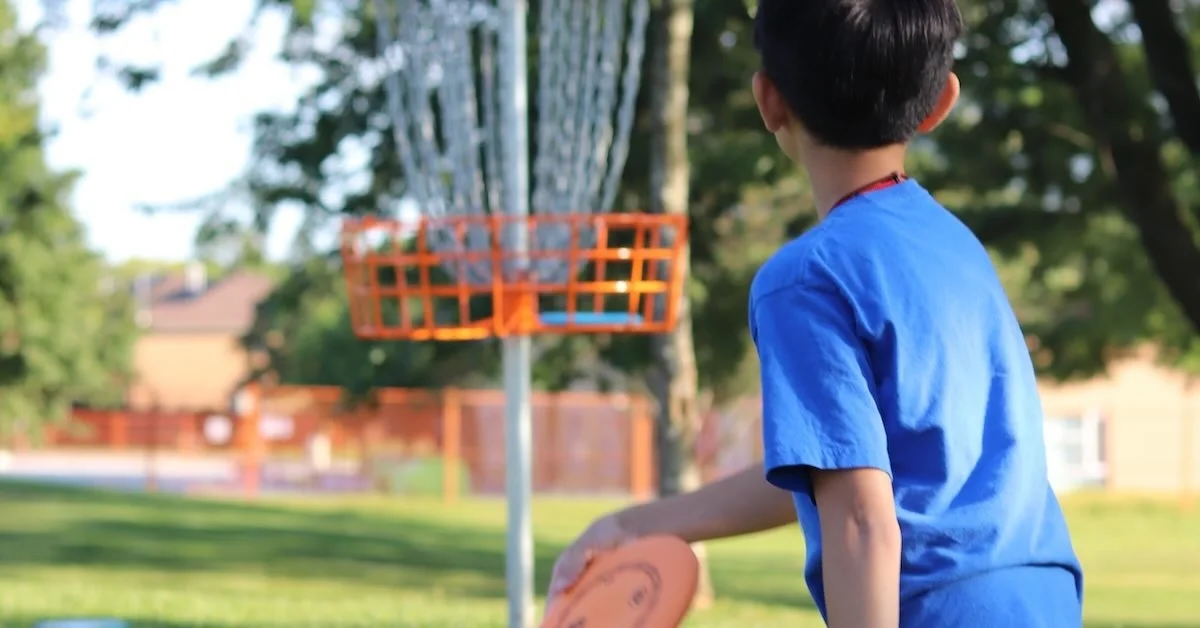
Another roadblock for disc golf that Farley saw was accessibility for those with limited mobility.
"We thrive in rough terrain, we thrive in the forests – and that's just not something that is realistic for a lot of mobility-challenged players," Farley said.
The third obstacle was the size of traditional disc golf courses. There were plenty of small parks and unused compact plots dotting neighborhoods that people passed by everyday, but a standard course – even a very small one – simply wouldn't fit in them. Was there a way to engineer a disc golf experience in such areas that would actually be fun?
Though Farley enjoys playing and designing remote and challenging traditional disc golf courses like the Fluent-built Wolf Tracks at Bondi, Big East, and Revelstoke, the issues he'd identified made it clear to him that focusing solely on such facilities wasn't the best path forward. That's why he began developing a small-footprint, accessible, and beginner-friendly disc golf experience he now calls Disc Golf Discovery Zone.
How Disc Golf Discovery Zones Make Small Courses Big Experiences
The first Disc Golf Discovery Zone was installed in Greenwood Park in the town of Whithurch-Stouffville, 31 miles/50 kilometers north of Toronto, Canada.
"They had a park that was in total maybe eight or nine acres [3.2 or 3.6 hectares]," explained Farley. "But the area of the park they wanted me to work in was essentially about one and a half acres [0.6 hectares]. When you think about traditional disc golf, a recreational course is gonna be on average one to two acres [0.4 to 0.8 hectares] per hole. So one and a half acres was ridiculous – it was essentially impossible."
Farley told the town that a traditional course wouldn't fit, but they were adamant about building some sort of disc golf experience on that parcel of land.
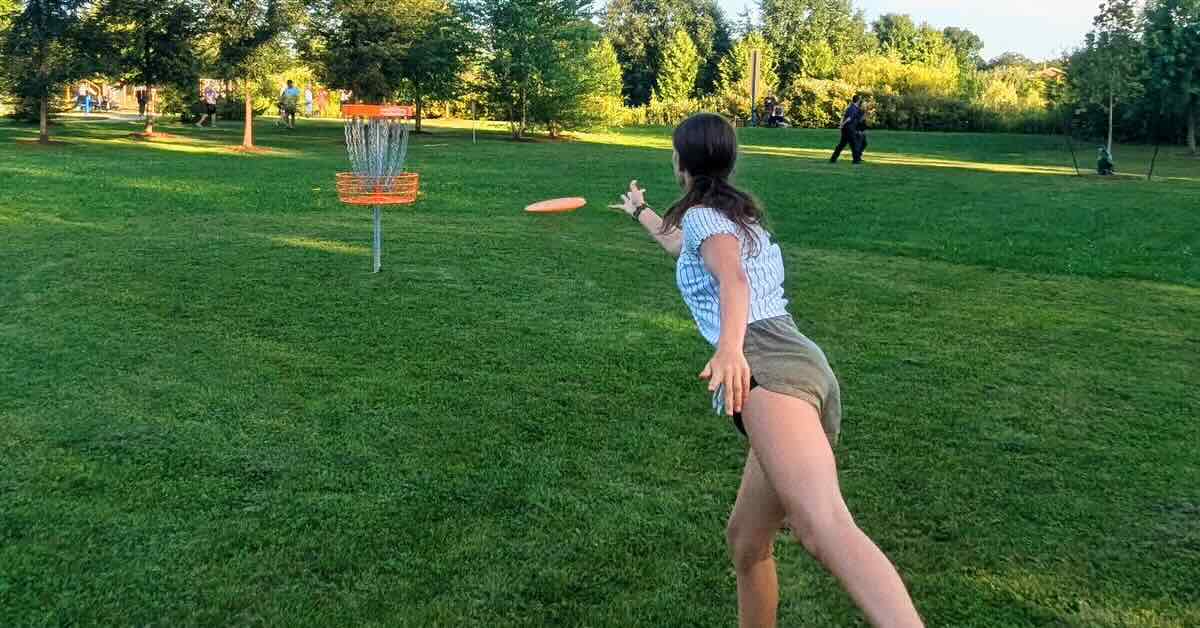
" I went back to the drawing board," said Farley. "I said, 'Let's see what we can do in a small space. How can we shrink it down and not just make it a mini?' As much as I like short courses that are out there – they certainly fill a need – I think they still suffer from needing too much space."
A lightbulb moment came when Farley realized he didn't have to build completely new holes to create new playing experiences. Instead, players could replay holes but have signage urging them to try out different throwing techniques each time they did. It was an iterative concept not far removed from the computer programming of his previous career.
For Greenwood Park, Farley created a course with five 100-foot/30-meter holes. A "round" is intended to consist of playing each hole twice, with the second time through teaching a different shot shape from the first – for instance, a hyzer backhand first and an anhyzer forehand second. Eleven new trees were planted in the park to further encourage players to throw specific shot shapes to reach baskets.
Teaching Through Tee Sign Graphics & Pro Instruction Via QR Code
To help new players learn each technique, Disc Golf Discovery Zone tee signs include silhouettes showing a person progressing through the movements needed to complete each throw. Farley calls these "form shadows," and the images were designed by WolfKat Discs.
Additionally, there are QR codes linking to videos of pro disc golfer Scott Stokely demonstrating how each throw works.
Stokely was a top contender in professional disc golf in the late 1990s, finishing second at the Pro Disc Golf World Championships in both 1997 and 1998. After a long break from the competitive scene, he returned to it about five years ago and began making a name for himself through social media presence, skill clinics, and respectable showings at elite tournaments.
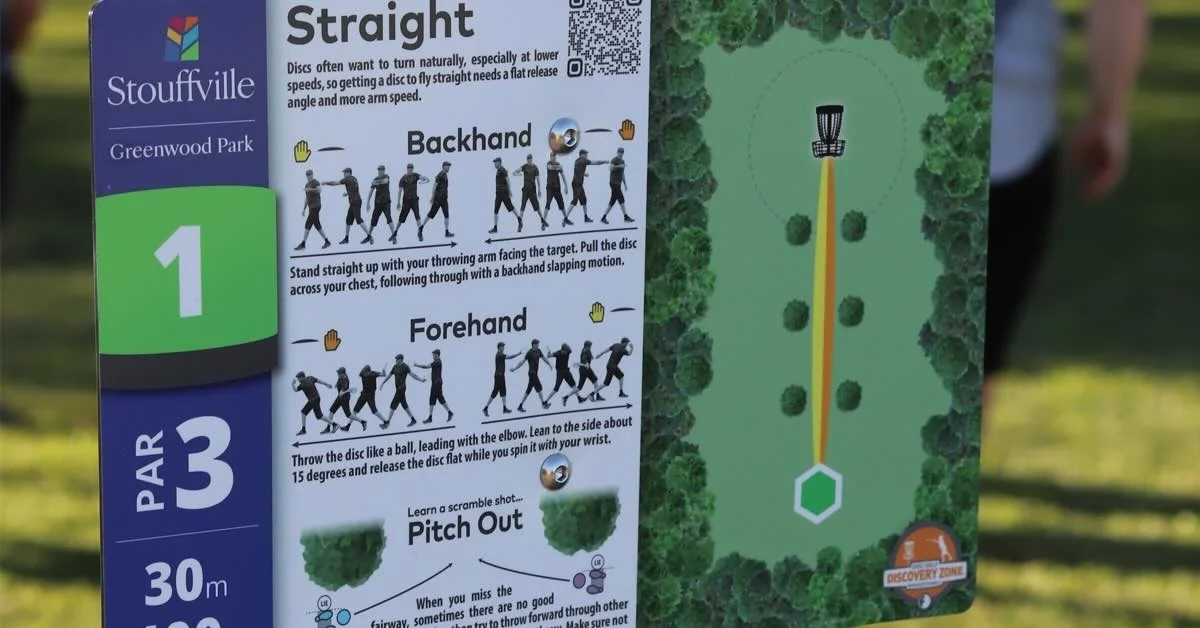
" I cold-called him through Facebook and put my little elevator pitch out there," said Farley. "Within a couple days we had organized a meeting, just a quick video call to show him what I'm doing."
After an hour of conversation, the two had a deal, with Stokely filming a series of videos for Disc Golf Discovery Zone that would allow every player with a smartphone to get top tier instruction on disc golf basics for free.
A Successful, Adaptable Formula for Compacting Disc Golf
Greenwood Park has been well-received in the community and by new players, with its wheelchair-accessible and stroller-friendly design allowing people of all abilities to enjoy and learn the sport. With several more Discovery Zones in the pipeline, Farley feels the concept will be a popular way to spread the sport – especially because it's simple to scale up or down.
Farley has designed three, four, five, and six-hole variants of the Disc Golf Discovery Zone, with signs encouraging up to three replays of each hole with a new throwing technique each time (meaning up to nine techniques for a three-hole course or 18 for a six-hole course). When a Discovery Zone includes more holes and three replays, players can go beyond basics and try out fun utility shots like grenades or patent-pending scrambles as well as different forms of putting.
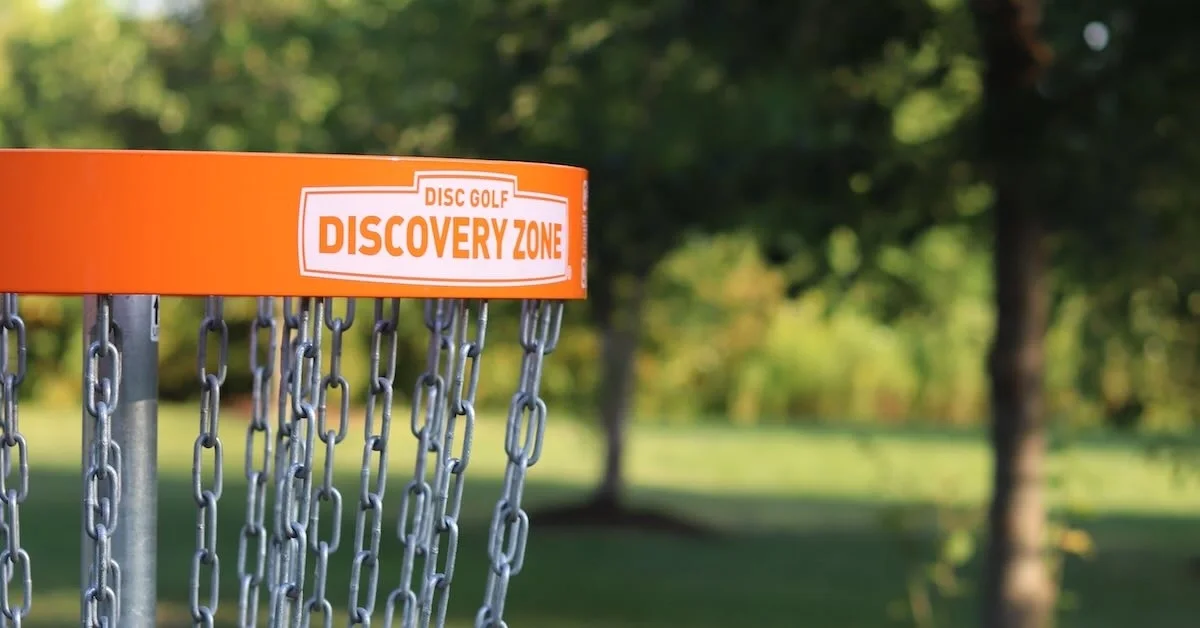
Farley has also worked hard to make installing Disc Golf Discovery Zones low-cost and straightforward.
Using GIS and satellite imagery, Farley designs a custom layout for the course without ever needing to visit the site in person, which is key to creating rapid and affordable expansion of the concept. Signage is made and printed for that specific course using local park branding. Installation guidelines and obstacle recommendations are also provided for the park. Fluent even has its own "Borealis" basket and can enable winter play through indoor and portable options Farley has developed.
" I wanted a solution that I could ship to a client on a single skid and have it be so simple that it's legitimately possible for a parks and rec department to lay out and install this in a public park with certain guardrails," Farley said.
In essence, Farley has created a one-stop-shop disc golf experience that's as simple for towns and cities to afford and install as it is for citizens and visitors to find and enjoy, making his method of compacting disc golf a win-win for all stakeholders.
